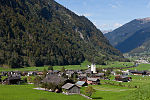Elm, Switzerland
Former municipalities of the canton of GlarusGlarus thrustSki areas and resorts in Switzerland

Elm (Romansh: ) is a village, and former municipality, in the municipality of Glarus Süd and canton of Glarus in Switzerland. Elm lies in the valley of the Sernf river, and consists of the village of Elm itself, and the hamlets of Sulzbach, Schwändi, Müsli, Untertal, Vogelsang, Töniberg, Obmoos, Steinibach and Wald.
Excerpt from the Wikipedia article Elm, Switzerland (License: CC BY-SA 3.0, Authors, Images).Elm, Switzerland
Sernftalstrasse, Glarus Süd
Geographical coordinates (GPS) Address Nearby Places Show on map
Geographical coordinates (GPS)
| Latitude | Longitude |
|---|---|
| N 46.916666666667 ° | E 9.1666666666667 ° |
Address
Sernftalstrasse
Sernftalstrasse
8767 Glarus Süd
Glarus, Switzerland
Open on Google Maps







